Exhibitions
MOA Museum of Art Collection Part III
2022.10.28(Fri) - 2022.12.11(Sun)
The 40th Anniversary

Overview
The Museum’s collection comprises works of art from Japan, China, and other Asian countries, each exemplary of a significant epoch in art history of Japan. It was formed for the main part by our founder Okada Mokichi (1882-1955) and encompasses a wide range of outstanding artworks of historical significance as well as of aesthetic excellence, ranging from paintings and calligraphic works to sculpture, handicraft, and beyond.
The final part of this year-long exhibition program highlights tea utensils, artworks representing the Rinpa school, and Buddhist paintings. Among them are masterpieces with the protected cultural heritage designation, including the Pair of Tea Bowls by Nonomura Ninsei, the illustrated handscroll The Tale of Princess Jōruri by Iwasa Matabei, and Mandala of Kichijoten (Srimahadevi), as well as the painting by Ogata Kōrin, The Empress Akikonomu. Enjoy a journey into the world of Japanese and East Asian art imbued with elegance and artistic finesse.

The Tale of Princess Jōruri attributed to Iwasa Matabei, Edo Period
This is the most vibrant and opulent work among the illustrated handscrolls attributed to Iwasa Matabei. The story unfolds as the main character Ushiwaka (Minamoto no Yoshitsune) travels to the north of Japan and, on his way, falls in love with Jōruri, a daughter of a local rich-and-powerful family in the town of Yahagi. The tale became a popular narrative repertoire often recited by blind monks in the late-sixteenth century. In the seventeenth century, it was adapted for puppetry and enjoyed a phenomenal success. The handscroll translates this piece of theatrical entertainment into a two-dimensional medium with the depiction of its scenes in astounding detail. The scripts placed on a side are based on the original play script and have all the descriptive details, from the design of Ushiwaka’s attire and the interior of maids’ chambers to the furniture in Jōruri’s bedroom and the words exchanged between the two main figures. These details are rendered richly with abundant use of expensive materials, such as gold foil and natural color pigments. In particular, the costume designs are rendered with meticulous intricacy. The people depicted with oblong heads strongly suggest that Matabei was overseeing the production. Provenance: the Matsudaira clan of Tsuyama domain.
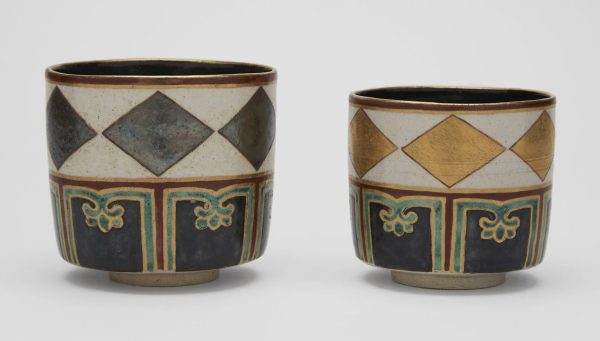
Pair of Tea Bowls with Lozenge Design in Gold and Silver (Important Cultural Property), Nonomura Ninsei, Edo Period
This pair of bowls is believed to have been commissioned by the tea master Kanamori Sōwa as a gift to Tōfukumon-in, a secondary wife of Emperor Go-Mizunoo. The body of the vessels is subtly convex, and the smaller bowl can sit snugly inside the larger one, dexterous work made possible by extraordinarily fine throwing, showcasing Ninsei’s masterful skills at a potter’s wheel. The rim is decorated with gold and red glazes, and the inside surfaces are covered with Ninsei’s original intense black glaze, which seems to enhance the exterior design. On the outside, the white base accommodates lozenges, one in silver and the other in gold, lined in red. The rather modern design transcends the bounds of time. A transparent glaze is applied on the bottom of the base, inside which is Ninsei’s signature. The bowls changed hands over time, from the Doi clan the ruler of the Sagami province to antique dealer Yamasumi, the Hirase family, and Baron Masuda Takashi. The bowls are included in a 19th-century catalog of masterpieces of tea utensils, Taishō Meiki Kan.
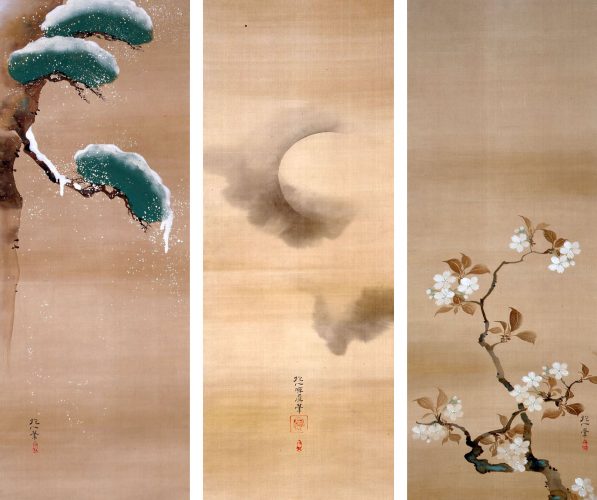
Snow, Moon and Flowers (Important Art Object), Sakai Hōitsu, Edo period
Born to a lord of Himeji domain, Sakai Hōitsu (1761–1828) spent his youth in Edo with abundant opportunities to enjoy the arts. He was passionate about paintings in particular and developed his original style inspired by Ogata Kōrin’s work. Snow, moon and flower are the motifs that, for centuries, captivated the Japanese through their appreciation of changing seasons. This genre thus existed from early on, painted notably by artists of the Kano school. The triptych forms a linear composition when put side by side, with the motifs arranged diagonally. It is a testimony to the artist’s reputation as a designer as well as a painter, poet and, most of all, an expert of the Rinpa school of art. The paintings are undoubtedly masterpieces of Sakai Hōitsu for the excellent selection of inks and beautiful brushwork. The inscription on the box indicates that he was 60 years old when these were created.
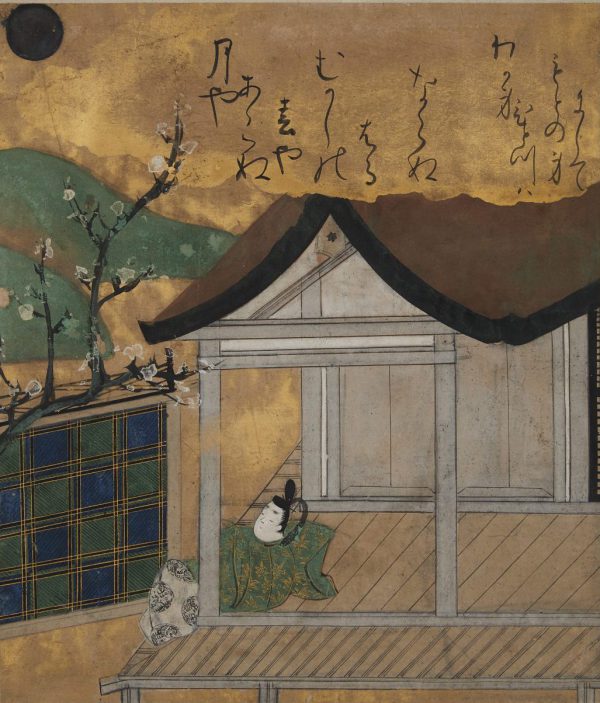
Story about Nishi-no-tai, a scene from the Tales of Ise attributed to Tawaraya Sōtatsu, Edo Period
Illustration of classical narratives was a favorite subject of Tawaraya Sōtatsu, who believed in the revival of the beauty of the classics. This version of the Tales of Ise is attributed to Tawaraya Sōtatsu. There are 47 pictures known today, all of which are unsigned by the artist and have the same square format. The script is written on all paintings except five. Its inscription reveals that the script was added to the pictures by a collection of the nobles and commoners who were adept at calligraphy. The section on display depicts Chapter Nishi-no-tai of the Tales, in which a man (supposedly modeled on Ariwara no Narihira) pays a visit to the house of a lady he was in love with but who no longer lives there. The figure in the painting is drawn in the archetypal style of “slit eyes and hook nose.” The clouds in gold beautifully crown the building and mountains. Chromatic illustrations of classical tales attributed to Sōtatsu typically have the quality to evoke dreamy sentiments as this one does.
(Script/poem) The moon is there but it does not look the same. Even the spring does not seem like before. I am the only existence who remain unchanged.
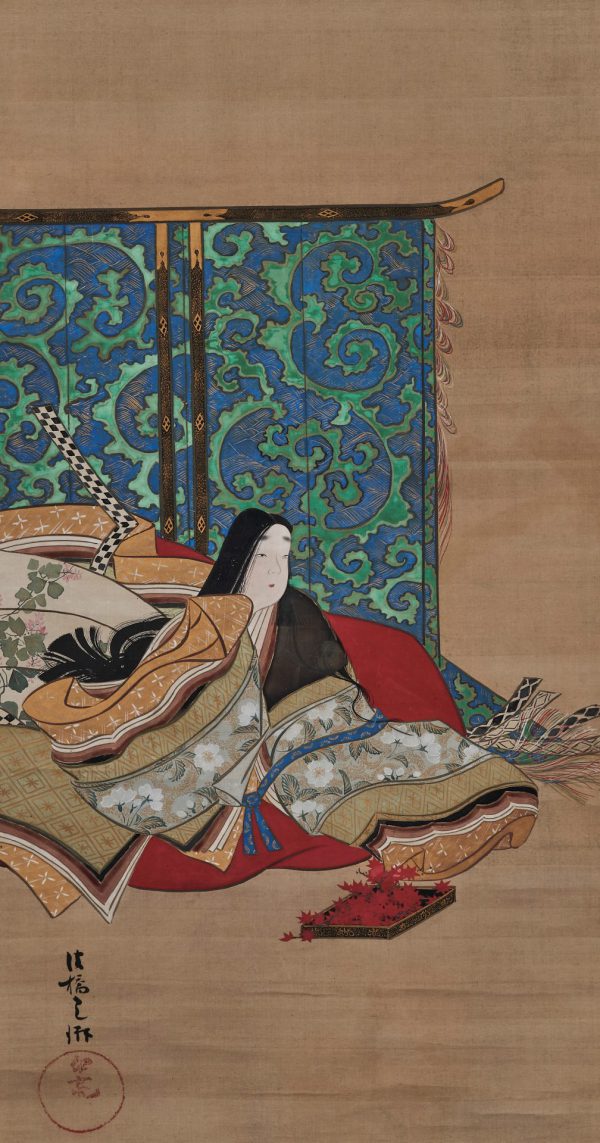
The Empress Akikonomu, Ogata Kōrin, Edo period
The empress in an elaborate and exuberant kimono is depicted elegantly, seated in front of a kichō (stand-alone drape) with a bold arabesque design. On the floor in front of her is a tray full of scarlet maple leaves. The scene is taken from Chapter 21 Otome of the Tale of Genji, as if to capture Empress Akikonomu, who loved autumn, from the course of a day at the imperial court, rendered gracefully. Ogata Kōrin made another painting as its counterpart, depicting a lady-in-waiting serving Empress Akikonomu (private collection). These are ones of Kōrin’s most celebrated paintings in the yamato-e style. The item on display is included in the Kōrin Shinsen Hyakuzu (New selection of one hundred illustrations by Kōrin) compiled by a 19th-century artist, Ikeda Koson.
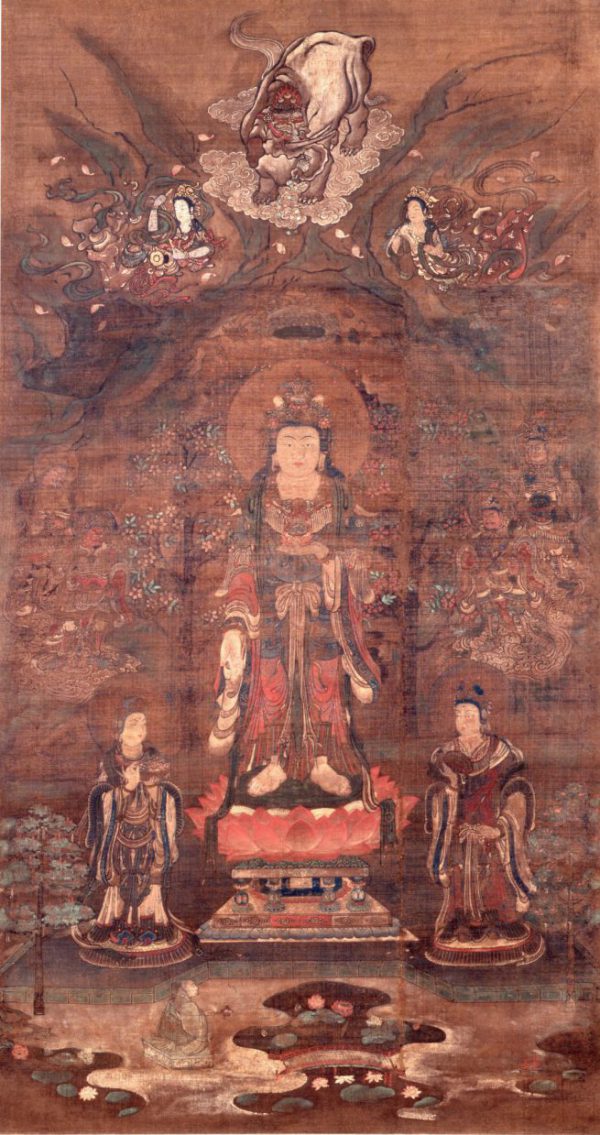
Mandala of Kichijoten (Srimahadevi) (Important Cultural Property), Kamakura Period
The goddess of happiness and virtue Kichijōten has been venerated for centuries and represented in numerous statues and paintings. This one holds a fortune stone, Chintamani, in her left hand and makes a varadamudra hand sign with her right one. She is accompanied by Bonten (Brahma) and Taishakuten (Sakro) on her sides while the Four Guardian Kings surround them. Toward the top of the mandala, nymphs are throwing confetti of lotus petals, and a white elephant is sitting on a carpet of clouds. Below the goddess, a bridge traverses a pond filled with beautiful lotus flowers, and a monk is conducting a ritual by the bridge. This is a rare example of colored mandala of the Dhāraṇiśvararāja Bodhisattva Sūtra, translated by Atikūta, depicting the tenet of Chapter 10. The painting retains its original design intact apart from the restored top section, where the white elephant is depicted. Provenance: the Kyōōgokokuji (also known as Tōji) temple in Kyoto.
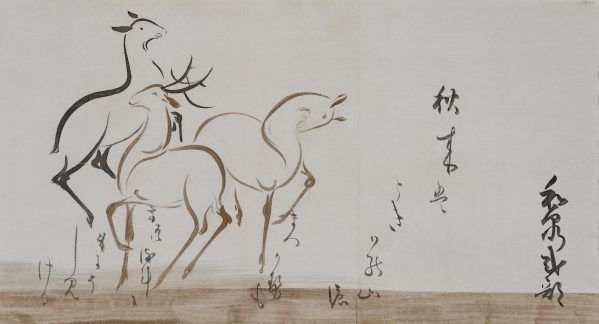
A fragment of poems on paper with design of deer, Tawaraya Sōtatsu and Hon’ami Kōetsu, Momoyama to Edo period (17th century)
This fragment was created from a scroll of 28 poems taken from the Shin Kokin Wakashū poetry anthology. Hon’ami Kōetsu selected the poems and transcribed them onto the paper designed by Tawaraya Sōtatsu. The illustration of deer in herds and groups, depicted in various postures, is rendered in gold and silver paints. The original scroll was reformed into two scrolls and a few fragments during the post-World-War period. Deer as a singular theme for the design elegantly evinces Sōtatsu’s artistic aptitude. The calligraphy complements the design with its extraordinary, decorative hand. The scroll made from the second half of the original is owned by the Seattle Art Museum in the USA. It bears Kōetsu’s signature “Tokuyūsai Kōetsu” and his trademark seal. This particular signature suggests that the scroll had been created before his latter days in Takagamine, Kyoto.
